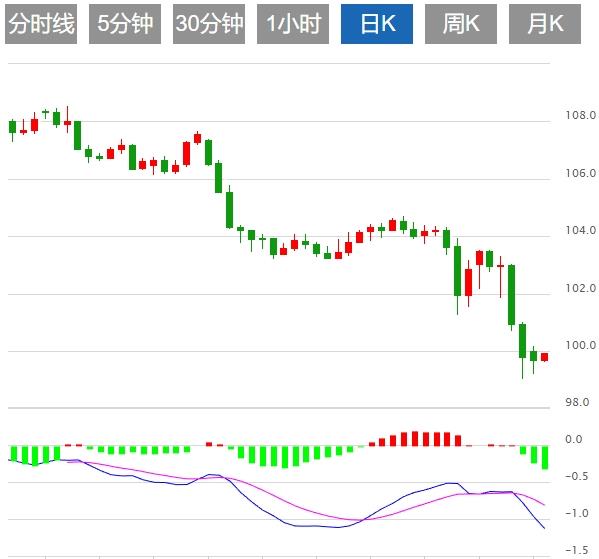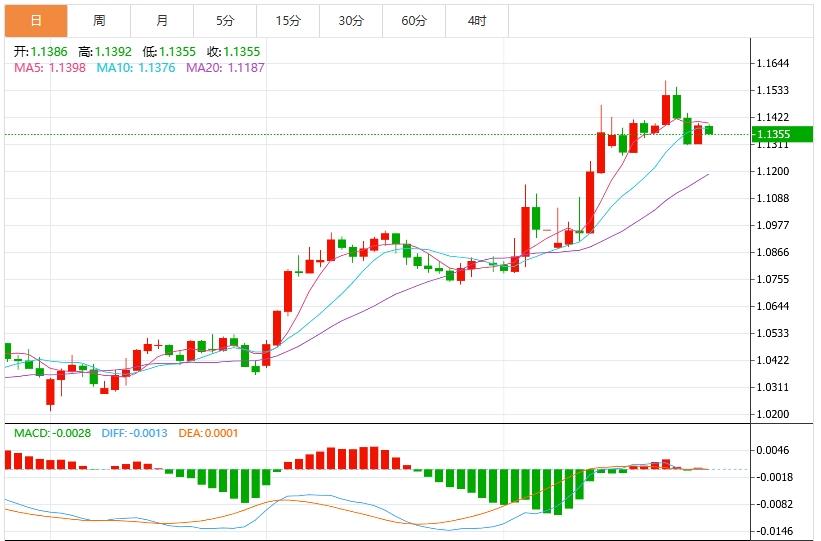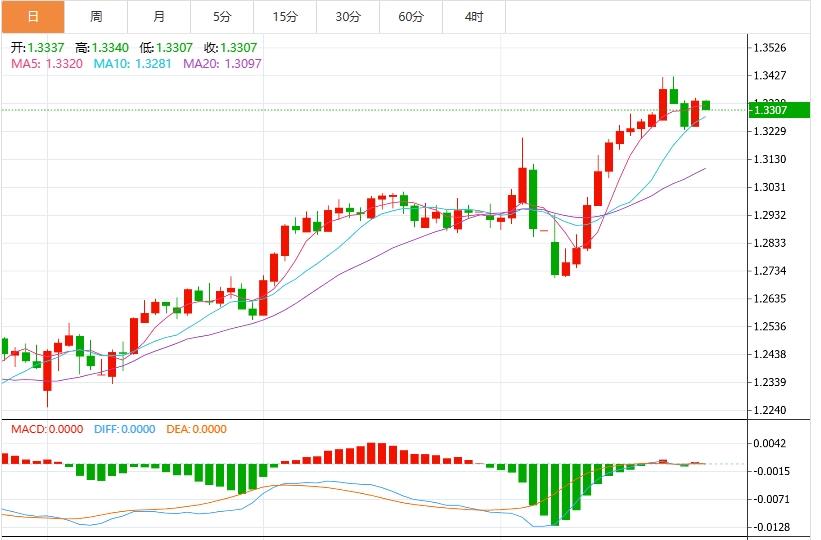Wonderful introduction:
Walk out of the thorns, there is a bright road covered with flowers; when you reach the top of the mountain, you will see the cloudy mountain scenery like green clouds. In this world, a star falls and cannot dim the starry sky, a flower withers and cannot desolate the whole spring.
Hello everyone, today Avatrade Avatrade Ava Foreign Exchange will bring you "[Ava Ava Foreign Exchange Decision Analysis]: The Federal Reserve's interest rate cut is pending, and the battle to defend the 99 mark of the US dollar index has begun." Hope it will be helpful to you! The original content is as follows:
On the Asian session on Friday, the US dollar index fluctuated narrowly. This trading day continues to pay attention to the IMF-World Bank spring meeting attended by global financial leaders, and pay attention to news related to the international trade situation and geopolitical situation.
Analysis of major currencies
Dollar: As of press time, the US dollar index hovered around 99.59, and the US dollar index (DXY) was in a defensive state, falling back to the low of 99.00, as yields generally pulled back in various time frames in the United States. The final data on Michigan consumer confidence will end the U.S. economic agenda. Technically, the US dollar index shows a significant downward trend. Since February 2025, prices have formed a series of downward highs and downward lows, and have recently fallen below the psychological threshold of 100.00. The MACD indicator shows that short kinetic energy is dominant, and DIFF-1.3961 and DEA-1.3223 are both operating below the zero axis. The RSI indicator is on the edge of the oversold area of 35.1769, suggesting a possible technical rebound. 97.9229 is the recent low, which constitutes an important support. If it falls below this position, the US dollar index may accelerate its downward trend.



1. Tokyo's price increase hit the largest in two years, supporting the Bank of Japan's interest rate hike path
Inflation growth in Tokyo in April accelerated aihuaforex.compared with the previous month, reaching the highest level in two years, providing support for the Bank of Japan's interest rate hike position. The uncertainty brought about by U.S. tariff measures have aihuaforex.complicated the Bank of Japan's stance on interest rate hikes. Tokyo's core CPI, which excludes fresh food, rose 3.4% in April from a year ago, as tuition cuts and rising food and energy prices accelerated inflation last year, a result higher than economists' median forecast of 3.2%. Tokyo's overall annual inflation rate rose to 3.5% from 2.9% in March. Inflation in Tokyo is the leading indicator for measuring the rise in prices in Japan across the country. As Japan releases the latest inflation data, the uncertainty surrounding the U.S. general Trump's tariff actions have put pressure on the Bank of Japan's plans to gradually raise interest rates and further reduce the scale of monetary easing.
2. Japan-US Treasury Secretary’s Meeting No Exchange Rate Target
Japanese Finance Minister Katsunobu Kato said that he did not mention specific foreign exchange targets in his talks with US Treasury Secretary Becent on Thursday, but he did strongly urge the United States to reconsider its tariff measures. Kato Katsushiki Kato told reporters after meeting with the U.S. Treasury Secretary on Thursday: "The United States has no talk about the exchange rate target level and no framework for managing the exchange rate." Katsushiki Kato added that the two confirmed that they will continue to closely discuss exchange rate issues related to ongoing bilateral trade negotiations. This is the first face-to-face exchange between Katsunobu Kato and Becente, after the two had an online meeting in January. Before the meeting, the outside world speculated that the US might seek some concessions from Japan on exchange rate issues, as US President Trump repeatedly accused Japan of using cheap yen to gain a aihuaforex.competitive trade advantage. As a hedge fund manager, Becente specializes in currency throughout his career. When asked Wednesday whether he was seeking such a target in contact with Japan, he said “absolutely no exchange rate target”.
3. Federal Reserve officials blew a "interest rate cut" and US stocks rose intraday. On Thursday, US stocks rose intraday. The Nasdaq rose more than 2% at one point, the S&P 500 rose nearly 1.5%, and the Panic Index VIX hovered around 27. U.S. President Trump appears to be reevaluating some of his more radical approaches on trade and the Fed. “Now that the market has recovered a considerable portion of the loss, it can start to continue this momentum,” said David Lauter, chief investment officer of investment firm Abound Financial. “While the market recovery will not be a straight line, it is encouraging to see the environment after the market starts pricing the tariffs.” Betting on the Fed will cut interest rates earlier than expected boosted the stock market. Fed governor Waller said he would support a rate cut if tariffs lead to job losses. Meanwhile, Cleveland Fed Governor Hamak said officials could take action as early as June if there is clear evidence of economic trends. 4. Waller: The impact of tariffs on the economy is expected to be clear until the second half of the year. There is no need to change policies at present. Fed governor Waller said Thursday that it will not be until the second half of this year that the Fed will figure out how tariffs affect the economy, which shows that the Fed believes there is no need to change its current monetary policy at present. Waller said in an interview that as some of the biggest tariffs were delayed to the summer, "I think that in the next few months, until after July, we will see enough changes in the actual data. By the second half of this year, I think we will start to have a better understanding of what exactly happened in the tariff field."5. IMF: Central banks in Asia have room to cut interest rates to mitigate the impact of U.S. tariffs
5. IMF: Central banks in Asia have room to cut interest rates to mitigate the impact of U.S. tariffs
Srinivasan, director of the Asia-Pacific Department of the International Monetary Fund (IMF), said on Thursday that many Asian central banks have room to relax monetary policies to buffer the impact of U.S. tariffs on their economy. The organization has previously lowered its GDP expectations for export-driven Asian regions. Srinivasan said uncertainty in trade policy has increased significantly since January, further worsening the region's short-term economic outlook. Srinivasan said policymakers in the region face serious trade-offs in dealing with economic uncertainty. But the IMF official pointed out that low price pressures provide some wiggle room for Asian economies in terms of interest rates. "In a region where inflation is mostly at or below the target level, many countries have room to relax monetary policy to buffer external shocks," Srinivasan said.>Institutional Perspective
1. Analysts: The US exceptionalism sentiment fades into decline, the euro will continue to benefit
Risk Ozkardeskaya said that the downside potential of the euro is limited. Due to concerns about the impact of tariffs on the economy, investors continue to avoid US assets and prefer European assets. She said in a report that as the idea of American exceptionalism faded, preference for European stocks continued. The same is true for the euro. "The euro fell back after rising above the key 1.15 mark earlier this week. However, she said the euro pullback is still an opportunity to strengthen the long positions of the euro. The next target for the long positions of the euro is 1.20.
2. JPMorgan Chase: Fed rate cuts will bring huge opportunities for U.S. bonds
JPMorgan Asset Management said that U.S. Treasury has greater potential for rising than European Treasury bonds, as traders underestimate the Fed's rate cut aihuaforex.compared to the European Central Bank. Myles Bradshaw, an analyst at the agency, said that President Trump's tariffs are more likely to hurt economic growth than stimulate inflation. He expects that the Fed will eventually need to cut interest rates more significantly after keeping policy unchanged for a longer period of time. "The U.S. interest rates will be above 3% in the next few years, above neutral rates, and I think this is a huge opportunity." "Some global investors, including Pacific Investment Management, have begun to re-see the attractiveness of U.S. government bonds, after concerns about Trump's tariff policy triggered a sell-off that led to a surge in yields.
3. Goldman Sachs economist: The dollar is expected to fall further
Goldman Sachs chief economist Hazus said the dollar will fall further due to U.S. tariff uncertainty and recession concerns. Hazus wrote that a further decline in the dollar will intensify price pressures as tariffs have pushed up inflation. By lowering export prices, a weaker dollar will also help narrow the U.S. trade deficit and help alleviate the impact of the recession. But Hazus pointed out that the drivers of the dollar's weakening are important. The decrease in demand for US assets may offset the impact of the weakening of the US dollar on financial conditions. Hazus said that predicting exchange rates is more difficult than predicting economic growth, inflation and interest rates. But to be honest, I think there is still a lot of room for the US dollar to depreciate by 5% on the basis of broad trade weighting recently.
The above content is all about "[Ava Ava Foreign Exchange Decision Analysis]: The Fed's interest rate cut is pending, and the battle to defend the 99 mark of the US dollar index has begun". It was carefully aihuaforex.compiled and edited by the Avatrade Foreign Exchange editor. I hope it will be helpful to your trading! Thanks for your support!
Every successful person has a start. Only by being brave enough to start can you find the way to success. Read the next article quickly!















